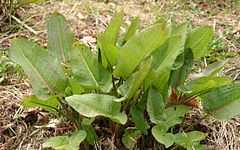Rumex obtusifolius
| Broadleaf Dock | |
|---|---|
 | |
| Scientific classification | |
| Kingdom: | Plantae |
| (unranked): | Angiosperms |
| (unranked): | Eudicots |
| (unranked): | Core eudicots |
| Order: | Caryophyllales |
| Family: | Polygonaceae |
| Genus: | Rumex |
| Species: | R. obtusifolius |
| Binomial name | |
| Rumex obtusifolius L. | |
Rumex obtusifolius, commonly known as broad-leaved dock, bitter dock, bluntleaf dock, dock leaf or butter dock, is a perennial weed, native to Europe but can now be found in the United States and many other countries around the world.
Description
Rumex obtusifolius is a perennial plant that grows to a height of 50 to 130 cm (20 to 51 in). It is easily recognizable by its very large oval leaves with cordate bases and rounded tips, some of the lower leaves having red stems. The edges of the leaves are slightly "crisped" or wavy, the upper surface is hairless and the under surface may be papillose. The leaves of this plant can grow to about 40 cm (16 in) in length. The stems are tough, often reddish, and unbranched until just below the inflorescence. The junctions of the stems are covered by two fused stipules which form an ocrea, a thin, paper-like membrane - a characteristic of the Polygonaceae family. The stem leaves are alternate and are narrowly ovate–lanceolate. The inflorescence consists of large clusters of racemes which contain small greenish flowers that change to red as they mature. The perianth-segments are in two whorls of three. Segments in the outer whorl are small and spreading while the inner whorl forms fruit valves, which are widely ovately-triangular. The seeds produced are dry and reddish-brown. This plant blooms June through September.[1]
Rumex crispus - curly dock - is very similar in appearance but with thinner and wavier leaves. In more detail, the calyx of curly dock has smooth margins while the calyx of broadleaf dock has horned margins.
Distribution and habitat
Rumex obtusifolius is widely distributed throughout the world. It is a plant of arable land, meadows, waste ground, roadsides, ditches and shorelines.[1]
Seedlings can be identified by the oval leaves with red stems and rolled leaves sprouting from the center of the plant.
Medicinal uses of the herb
The 'milk' of the dock leaf is known to contain tannins and oxalic acid, which is an astringent.[2]
Other historical uses
In George Eliot's Adam Bede, set in the early 19th century, broad dock leaves are used to wrap farmhouse butter.[3]
Eradication
Broadleaf dock is considered a weed and is slightly poisonous. It is designated an "injurious weed" under the UK Weeds Act 1959.[4] Livestock have been known to get sick after feeding on it. But eradicating the plants is difficult. The perennial plant can have a deep taproot reaching 5 feet down. Also, the milk of the plant has been known to cause mild dermatitis.
Seeds have toothed wing structures, allowing them to be dispersed by wind or water, and also allow them to attach to animals or machinery to be spread great distances. They can lie dormant for years before germination, making vigilant pulling or tilling essential.
First year plants can seed, making early detection important for eradication.
The main weaknesses of Broadleaf are its poor competition, crowding causes flowering to be delayed for up to three years, and its susceptibility to disturbance. Frequent tilling will disrupt the roots and kill the older plants and seedlings. The plant also thrives in moist environments and improved drainage can also help control its growth.[citation needed]
It has also been an invasive species of the Great lakes region where it was first sighted in 1840.[5]
References
| Wikimedia Commons has media related to Rumex obtusifolius. |
| Wikispecies has information related to: Rumex obtusifolius |
- ↑ 1.0 1.1 "Broad-leaved Dock: Rumex obtusifolius". NatureGate. Retrieved 2013-12-30.
- ↑ Rumex. Yellow dock, Curled dock. Rumex crispus, Rumex obtusifolius. | Henriette's Herbal Homepage
- ↑ Eliot, George (1859). Adam Bede (Modern Library, 2002); p93-94.
- ↑ http://www.defra.gov.uk/farm/wildlife/weeds/
- ↑ "List of Invasive species in the Great Lakes Great Lakes United / Union Saint-Laurent Grands Lacs". Retrieved 2009-02-07.